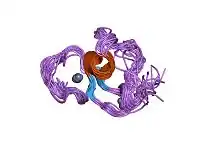| BAZ1B | |||||||||||||||||||||||||||||||||||||||||||||||||||
|---|---|---|---|---|---|---|---|---|---|---|---|---|---|---|---|---|---|---|---|---|---|---|---|---|---|---|---|---|---|---|---|---|---|---|---|---|---|---|---|---|---|---|---|---|---|---|---|---|---|---|---|
 | |||||||||||||||||||||||||||||||||||||||||||||||||||
| |||||||||||||||||||||||||||||||||||||||||||||||||||
| Identifiers | |||||||||||||||||||||||||||||||||||||||||||||||||||
| Aliases | BAZ1B, WBSCR10, WBSCR9, WSTF, bromodomain adjacent to zinc finger domain 1B | ||||||||||||||||||||||||||||||||||||||||||||||||||
| External IDs | OMIM: 605681 MGI: 1353499 HomoloGene: 22651 GeneCards: BAZ1B | ||||||||||||||||||||||||||||||||||||||||||||||||||
| |||||||||||||||||||||||||||||||||||||||||||||||||||
| |||||||||||||||||||||||||||||||||||||||||||||||||||
| |||||||||||||||||||||||||||||||||||||||||||||||||||
| |||||||||||||||||||||||||||||||||||||||||||||||||||
| Wikidata | |||||||||||||||||||||||||||||||||||||||||||||||||||
| |||||||||||||||||||||||||||||||||||||||||||||||||||
Tyrosine-protein kinase, or Bromodomain adjacent to zinc finger domain, 1B (BAZ1B) is an enzyme that in humans is encoded by the BAZ1B gene.[5][6][7]
Function
This gene encodes a member of the bromodomain protein family. The bromodomain is a structural motif characteristic of proteins involved in chromatin-dependent regulation of transcription. This gene is deleted in Williams-Beuren syndrome, a developmental disorder caused by deletion of multiple genes at 7q11.23.[7]
BAZ1B has been found to affect the activity of 448 other genes and is very important in the development of the neural crest and the face. Research suggests that changes in BAZ1B may have been involved in "self-domesticating" humans.[8][9]
References
- 1 2 3 GRCh38: Ensembl release 89: ENSG00000009954 - Ensembl, May 2017
- 1 2 3 GRCm38: Ensembl release 89: ENSMUSG00000002748 - Ensembl, May 2017
- ↑ "Human PubMed Reference:". National Center for Biotechnology Information, U.S. National Library of Medicine.
- ↑ "Mouse PubMed Reference:". National Center for Biotechnology Information, U.S. National Library of Medicine.
- ↑ Peoples RJ, Cisco MJ, Kaplan P, Francke U (Feb 1999). "Identification of the WBSCR9 gene, encoding a novel transcriptional regulator, in the Williams-Beuren syndrome deletion at 7q11.23". Cytogenetics and Cell Genetics. 82 (3–4): 238–46. doi:10.1159/000015110. PMID 9858827. S2CID 46824270.
- ↑ Lu X, Meng X, Morris CA, Keating MT (December 1998). "A novel human gene, WSTF, is deleted in Williams syndrome". Genomics. 54 (2): 241–9. doi:10.1006/geno.1998.5578. PMID 9828126.
- 1 2 "Entrez Gene: BAZ1B bromodomain adjacent to zinc finger domain, 1B".
- ↑ Zanella M, Vitriolo A, Andirko A, Martins PT, Sturm S, O'Rourke T, et al. (December 2019). "Dosage analysis of the 7q11. 23 Williams region identifies BAZ1B as a major human gene patterning the modern human face and underlying self-domestication". Science Advances. 5 (12): eaaw7908. Bibcode:2019SciA....5.7908Z. doi:10.1126/sciadv.aaw7908. PMC 6892627. PMID 31840056.
- ↑ Marshall M (Dec 14, 2019). "A single gene controls how our faces develop when we are young". New Scientist.
Further reading
- The Washington University Genome Sequencing Cente (November 1998). "Toward a complete human genome sequence". Genome Research. 8 (11): 1097–108. doi:10.1101/gr.8.11.1097. PMID 9847074.
- Jones MH, Hamana N, Nezu J, Shimane M (January 2000). "A novel family of bromodomain genes". Genomics. 63 (1): 40–5. doi:10.1006/geno.1999.6071. PMID 10662543.
- Pascual J, Martinez-Yamout M, Dyson HJ, Wright PE (December 2000). "Structure of the PHD zinc finger from human Williams-Beuren syndrome transcription factor". Journal of Molecular Biology. 304 (5): 723–9. doi:10.1006/jmbi.2000.4308. PMID 11124022.
- Bozhenok L, Wade PA, Varga-Weisz P (May 2002). "WSTF-ISWI chromatin remodeling complex targets heterochromatic replication foci". The EMBO Journal. 21 (9): 2231–41. doi:10.1093/emboj/21.9.2231. PMC 125993. PMID 11980720.
- Kitagawa H, Fujiki R, Yoshimura K, Mezaki Y, Uematsu Y, Matsui D, et al. (June 2003). "The chromatin-remodeling complex WINAC targets a nuclear receptor to promoters and is impaired in Williams syndrome". Cell. 113 (7): 905–17. doi:10.1016/S0092-8674(03)00436-7. PMID 12837248.
- Beausoleil SA, Jedrychowski M, Schwartz D, Elias JE, Villén J, Li J, et al. (August 2004). "Large-scale characterization of HeLa cell nuclear phosphoproteins". Proceedings of the National Academy of Sciences of the United States of America. 101 (33): 12130–5. Bibcode:2004PNAS..10112130B. doi:10.1073/pnas.0404720101. PMC 514446. PMID 15302935.
- Poot RA, Bozhenok L, van den Berg DL, Steffensen S, Ferreira F, Grimaldi M, et al. (December 2004). "The Williams syndrome transcription factor interacts with PCNA to target chromatin remodelling by ISWI to replication foci". Nature Cell Biology. 6 (12): 1236–44. doi:10.1038/ncb1196. PMID 15543136. S2CID 23842462.
- Andersen JS, Lam YW, Leung AK, Ong SE, Lyon CE, Lamond AI, Mann M (January 2005). "Nucleolar proteome dynamics". Nature. 433 (7021): 77–83. Bibcode:2005Natur.433...77A. doi:10.1038/nature03207. PMID 15635413. S2CID 4344740.
- Fujiki R, Kim MS, Sasaki Y, Yoshimura K, Kitagawa H, Kato S (November 2005). "Ligand-induced transrepression by VDR through association of WSTF with acetylated histones". The EMBO Journal. 24 (22): 3881–94. doi:10.1038/sj.emboj.7600853. PMC 1283952. PMID 16252006.
- Percipalle P, Fomproix N, Cavellán E, Voit R, Reimer G, Krüger T, et al. (May 2006). "The chromatin remodelling complex WSTF-SNF2h interacts with nuclear myosin 1 and has a role in RNA polymerase I transcription". EMBO Reports. 7 (5): 525–30. doi:10.1038/sj.embor.7400657. PMC 1479564. PMID 16514417.
- Nousiainen M, Silljé HH, Sauer G, Nigg EA, Körner R (April 2006). "Phosphoproteome analysis of the human mitotic spindle". Proceedings of the National Academy of Sciences of the United States of America. 103 (14): 5391–6. Bibcode:2006PNAS..103.5391N. doi:10.1073/pnas.0507066103. PMC 1459365. PMID 16565220.
- Cavellán E, Asp P, Percipalle P, Farrants AK (June 2006). "The WSTF-SNF2h chromatin remodeling complex interacts with several nuclear proteins in transcription". The Journal of Biological Chemistry. 281 (24): 16264–71. doi:10.1074/jbc.M600233200. PMID 16603771.
- Olsen JV, Blagoev B, Gnad F, Macek B, Kumar C, Mortensen P, Mann M (November 2006). "Global, in vivo, and site-specific phosphorylation dynamics in signaling networks". Cell. 127 (3): 635–48. doi:10.1016/j.cell.2006.09.026. PMID 17081983. S2CID 7827573.
External links
- BAZ1B+protein,+human at the U.S. National Library of Medicine Medical Subject Headings (MeSH)
- Human BAZ1B genome location and BAZ1B gene details page in the UCSC Genome Browser.
This article incorporates text from the United States National Library of Medicine, which is in the public domain.





